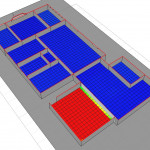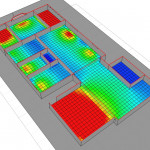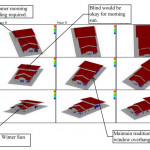Shading and Daylighting
Using Ecotect and some custom scripts, it’s possible to quickly generate “views from the sun”. Using Radiance, we can calculate the amount of natural light we’ll get from the windows, and which are will be dark. Some examples are below:
| asdf |
From this analysis, the preliminary design can be modified to account for:
Shaded in Summer, warm in Winter
- The 1500 eave to the east, above the clearstory, is excessive. A 600-900 eave would improve daylight and solar in Winter. A blind or shade would be required in Summer in any case. See diagram.
- The 1500 west eave is good, and could be bigger for SUmmer afternoon (e.g. 1800). This looks okay, but might make construction difficult (truss overhang).
- The 900 north eave is good – blocking all Summer and just letting in most Winter sun.
- South eave is not important – make 600 (fine) – 900 (symmetrical with North)
- Summer mornings in front bedroom are hot. Add external movable shades, or good internal blinds. A 600 overhang is ineffective here.
- A 600 overhang to the northern windows works well.
Daylight
- The clearstory doesn’t add a lot of daylight because of the existing large sliding doors, but is useful in reducing contrast glaze and evening-out illumiunation. The 600 high could be increased.
- The
Other
- The high-level clearstory to the deck on the north, if openable (e.g. lourves, shutters), would provide morning winter light. The deck is very well lit already. Rain would enter easily here, so covering it is good. Options are (1) fixed blade or operable shutters (2) danpalon (3) fixed custom timber screen. For (3), angling the blades to let in north sun would block the Summer sun and allow Winter sun in.
- The high-level clearstory to the kitchen the same deal. Probably need an external operable shade for Summer mornings, or internal good blind.






